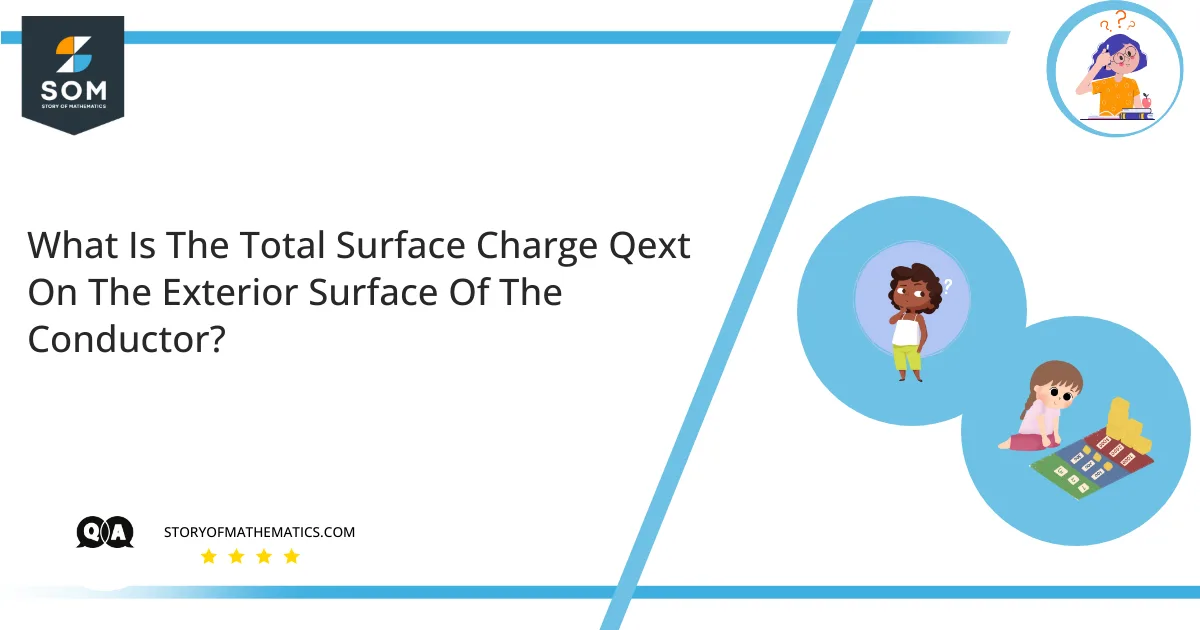 – In a conducting sphere with a neutral charge, there exists a hollow cavity inside it in the form of a sphere. There is a point charge present at the center of the spherical cavity having a positive charge $q$.– (A) For the given conductor, find the total charge $q_{int}$ that exists on its internal surface i.e on the inside wall of the hollow sphere.– (B) For the given conductor, find the total charge $q_{ext}$ that exists on its external surface i.e on the outside wall of the hollow sphere.– (C) Calculate the magnitude of the electric field $\vec{E_f}$ that exists inside the hollow cavity with respect to the position of point charge $q$ assuming $k$ as follows:\[k=\frac{1}{4\pi\varepsilon_o}\]
– In a conducting sphere with a neutral charge, there exists a hollow cavity inside it in the form of a sphere. There is a point charge present at the center of the spherical cavity having a positive charge $q$.– (A) For the given conductor, find the total charge $q_{int}$ that exists on its internal surface i.e on the inside wall of the hollow sphere.– (B) For the given conductor, find the total charge $q_{ext}$ that exists on its external surface i.e on the outside wall of the hollow sphere.– (C) Calculate the magnitude of the electric field $\vec{E_f}$ that exists inside the hollow cavity with respect to the position of point charge $q$ assuming $k$ as follows:\[k=\frac{1}{4\pi\varepsilon_o}\]This article aims to find the impact of
point charge placed in
conducting sphere and the
magnitude of the Electric Field generated.The basic concept behind this article is
Gauss’s Law for the Electric field.
Expert Answer
Given that:A
point positive charge $q$ is placed inside a
spherical cavity with
radius $R$ inside a
conducting sphere.As per
Gauss’s Law, the total
electric flux is:\[\Phi_E=\oint\vec{E_f}\bullet\vec{ds}=\frac{q+q_{int}}{\varepsilon_o}\]Where:$q=$
Charge at the center$q_{int}=$
Charge induced on the inner surfacePart (A)In a
neutral sphere, the
electrical field and
flux are
zero, hence:\[\Phi_E=\oint\vec{E_f}\bullet\vec{ds}=\frac{q+q_{int}}{\varepsilon_o}=0\]\[q+q_{int}=0\]\[q_{int}=-q\]
Part (B)In a
neutral sphere, the
net charge across its internal and external surface will be zero.\[q_{int}{+q}_{ext}=0\]\[q_{ext}=-q_{int}\]\[q_{ext}=-(-q)=q\]
Part (C)Let’s assume a point at a distance $r$ from the
center of the cavity and $r<R$, so\[q_{enclosed}=q\]Hence:\[\Phi_E=\vec{E_f}\bullet A_{cavity}=\frac{q_{enclosed}}{\varepsilon_o}\]\[\vec{E_f}=\frac{q_{enclosed}}{{A_{cavity}\times\varepsilon}_o}\]\[\vec{E_f}=\frac{q}{{4\pi r^2\varepsilon}_o}=\frac{kq}{r^2}\]
Numerical Result
The t
otal charge $q_{int}$ that exists on the
inside wall of the
hollow sphere is “$-q$”.The
total charge $q_{ext}$ that exists on the
outside wall of the
hollow sphere is “$q$”.The
magnitude of the electric field $\vec{E_f}$ inside the
hollow cavity is:\[\vec{E_f}=\frac{q}{{4\pi r^2\varepsilon}_o}=\frac{kq}{r^2}\]
Example
A
point charge is present at the
center of the spherical cavity having a
positive charge $q$. An
external charge $q_2$ is brought near the
conducting sphere.
(A) Find the
change in the total charge $q_{int}$ on the
interior surface of the cavity.
(B) Find the
change in the total charge $q_{ext}$ on the
exterior of the conductor.
(C) Find the
change in the Electric field $E_{cav}$
inside the cavity.
(D) Find the
change in the Electric field $E_{ext}$
outside the conductor.
SolutionPart (A)The
total charge $q_{int}$ is only dependent on the
positive charge $q$ placed in the
center, hence it will not change in the presence of
external charge $q_2$.
Part (B)The
total charge $q_{ext}$ is only dependent on the
positive charge $q$ placed in the
center, hence it will not change in the presence of
external charge $q_2$.
Part (C)Electric field $E_{cav}$ inside the cavity will not change because the
conducting sphere is neutral and the
electrical field inside the cavity is only dependent on the
positive charge $q$.\[\vec{E_f}=\frac{q_{enclosed}}{{A_{cavity}\times\varepsilon}_o}\]
Part (D)Electric field $E_{ext}$
outside the cavity will change because it will be
distorted or affected by external charge $q_2$.
 – In a conducting sphere with a neutral charge, there exists a hollow cavity inside it in the form of a sphere. There is a point charge present at the center of the spherical cavity having a positive charge $q$.– (A) For the given conductor, find the total charge $q_{int}$ that exists on its internal surface i.e on the inside wall of the hollow sphere.– (B) For the given conductor, find the total charge $q_{ext}$ that exists on its external surface i.e on the outside wall of the hollow sphere.– (C) Calculate the magnitude of the electric field $\vec{E_f}$ that exists inside the hollow cavity with respect to the position of point charge $q$ assuming $k$ as follows:\[k=\frac{1}{4\pi\varepsilon_o}\]This article aims to find the impact of point charge placed in conducting sphere and the magnitude of the Electric Field generated.The basic concept behind this article is Gauss’s Law for the Electric field.
– In a conducting sphere with a neutral charge, there exists a hollow cavity inside it in the form of a sphere. There is a point charge present at the center of the spherical cavity having a positive charge $q$.– (A) For the given conductor, find the total charge $q_{int}$ that exists on its internal surface i.e on the inside wall of the hollow sphere.– (B) For the given conductor, find the total charge $q_{ext}$ that exists on its external surface i.e on the outside wall of the hollow sphere.– (C) Calculate the magnitude of the electric field $\vec{E_f}$ that exists inside the hollow cavity with respect to the position of point charge $q$ assuming $k$ as follows:\[k=\frac{1}{4\pi\varepsilon_o}\]This article aims to find the impact of point charge placed in conducting sphere and the magnitude of the Electric Field generated.The basic concept behind this article is Gauss’s Law for the Electric field.